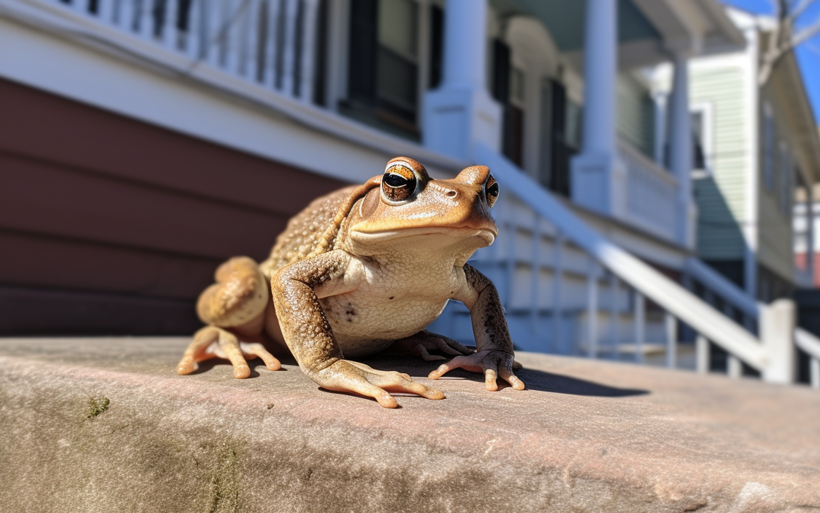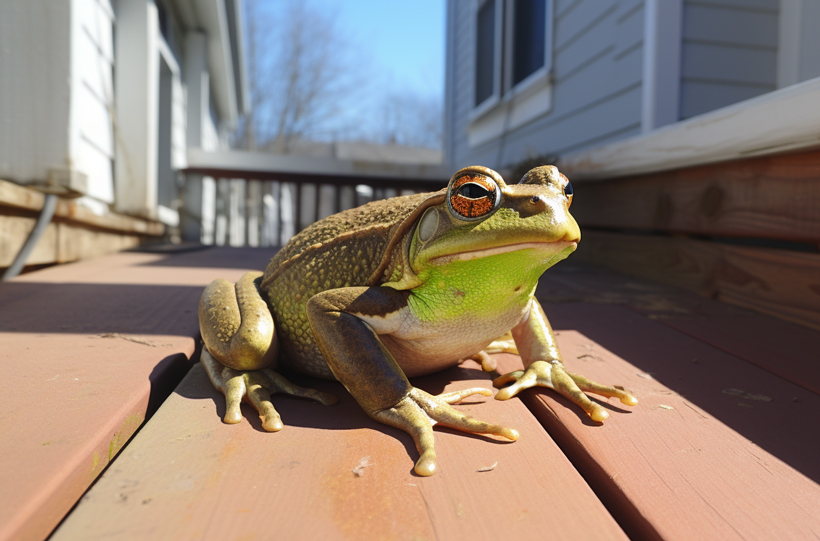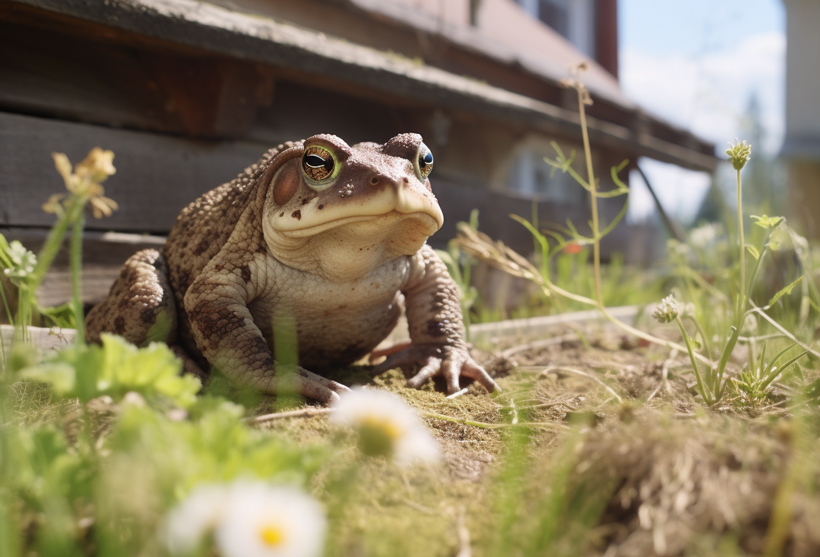Frogs sometimes enter your houses, creating problems because they can drag other harmful animals with them, like snakes. But frogs are also bioindicators. They can provide information on the condition of your garden, grass, and shrubs.
However, how do frogs get in the house? Frogs can infiltrate houses through
- Cracks
- Spaces around doors
- Windows
- Faulty screens and other openings
Moreover, moisture, artificial light, and neighboring water supplies all draw them into the house. In that sense, maintaining a suitable living area involves proper sealing and dehumidification.
Go further if you want to learn more about how frogs get in the house. To make the most of your time, I’ll go through it in depth on this topic. I hope you will continue reading!
How do Frogs Get in the House?

The reasons for which frogs get in the house are given below:
Light Sources
This is an important factor which is unknown to many. Frogs are curious about lights. For this reason, they go near light sources and sometimes find insects they eat.
- Frog Attraction to Artificial Light: Frogs are drawn to artificial light, such as that from street lamps. This appeal could tempt them to wander toward well-lit locations, which might unintentionally direct them indoors.
- Influence of the mating season: During the frogs’ breeding season, frogs being drawn to light is particularly evident. Frogs are known to become more active at this time and may seek out well-lit areas.
Water and Moisture Sources
Frogs naturally favor wet environments, which is why they frequently choose locations with greater humidity levels. Homes with dripping faucets, leaking pipes, or moist basements may unintentionally attract frogs. This is because they view these sites as possible water supplies.

Frogs can be attracted to residential areas by the existence of water features. This includes fountains, ponds, or pools nearby. Frogs are drawn to these areas because they imitate natural breeding grounds. And collections of water, which might sometimes bring them indoors.
Cracks and Openings
Frogs may have the chance to enter indoor areas through structural flaws in dwellings. These crafty critters can take advantage of even tiny gaps. A broken door and window might undermine the seal, leaving gaps that frogs can access.
Frogs can accidentally find their way into homes through tiny, unnoticed spaces, such as those surrounding windows, doors, vents, and foundations. They use these apertures to enter inside spaces because of their flexible bodies.
Frogs can hop inside buildings in search of safety from the outdoors if there are no functional screens. Doors with gaps that don’t fit properly might unintentionally serve as a frog entry point.
Frogs can fit through the area beneath the door, especially if they’re looking for shelter. Even though they are tiny, these openings are wide enough for frogs to pass through.
These are the main reasons that frogs get in the houses.
How to Prevent Frogs from Entering Houses?

A few techniques are given below that can be followed to prevent frogs from entering houses:
Seal Entry Points
A proactive step to prevent frogs from entering homes is to effectively block any potential access spots. Homeowners may considerably lower the likelihood of frog incursion by fixing cracks and openings in numerous places.
Pay particular attention to any entry of various materials since they frequently create openings over time.
- Sealing Methods: Use the proper sealants, caulk, or weather stripping to properly seal gaps and cracks. Use these items to build a physical barrier that frogs cannot readily cross.
- Door Sweeps: To close the space between the door and the threshold, install door sweeps at the bottom of the door.
- Maintaining Screens: Check to see that the screens on your windows and vents are in good shape and free of damage.
Secure access to Moisture

It’s essential to reduce moisture sources within and around houses to prevent frogs from looking for shelter.
- Prompt Leak Repairs: Immediately fix any leaks in pipes, faucets, or roofs after discovering them. Frogs lose access to the wet environments they are attracted to when sources of excess moisture are removed.
- Dehumidifier Usage: Use a dehumidifier to maintain the ideal moisture levels in locations that are subject to excessive humidity, such as basements or crawl spaces. You may deter frogs from using these spots for refuge by keeping them dry.
- Aversion to Dry Conditions: Frogs like wet habitats, so you need to try to keep the environment dry. Therefore, keeping drier living circumstances might lessen their attraction to dampness.
Outdoor Lighting Adjustment

The attractiveness of frogs can be reduced by homeowners deliberately changing lighting arrangements. For example,
- Light Direction: Turn outdoor lighting away from doors and windows. Frogs are less likely to follow the light inside by blocking light from beaming straight into the home.
- Motion Sensor Lights: Choose motion-sensor lights to illuminate the areas of your home. With this strategy, the persistent lighting that can attract frogs is minimized. By using this, lights will turn on automatically and prevent frogs from entering.
Create Barriers
Frogs can’t enter your property if there are strong obstacles around possible entrance sites. You can drastically lower the likelihood of frog entry by restricting their mobility.
- Mesh or Netting: Install mesh or netting over water features, such as fountains or ponds, to keep frogs away from your house. As a result, they are unable to enter any locations that could appeal to them.
Landscaping
Strategic landscaping techniques help to reduce frog activity near houses, such as
- Water feature buffer zone: Maintain a safe distance between your property and any water features in the area. This keeps frogs from thinking of your home as a viable breeding place.
- Vegetation Management: Trim the grass around windows and doors to remove any hiding places that can draw frogs. By clearing these areas, you can decrease the possibility of their entry. Frogs use the plants to cover themself and reach close to your house.
Cleanliness

Maintaining the cleanliness of any ponds close to your home is necessary.
- Maintenance of the pond: Ponds must be regularly maintained if they are to remain inhospitable to frogs. This will entail maintaining the pond’s cleanliness.
- Clear the Junk: Remove any leaves, twigs, and other organic waste that may be amassed in the pond. For protection and nourishment, frogs are drawn to these places.
- Stop the growth of algae: Excessive algae can feed frogs and draw insects, which are another source of food for them. Use the proper techniques to limit the growth of algae, such as introducing beneficial microorganisms or sparingly utilizing algaecides.
- Install a pond skimmer: It helps to remove floating debris and insects from the water’s surface. A pond skimmer can help cut down on frogs’ access to food.
- Utilize Pond Plants: Include pond vegetation like floating plants and water lilies. These protect fish and minimize open water areas where frogs could lay their eggs. It also supports the environmental balance of ponds.
All these methods help to create a living place that is comfortable and amphibian-free.
Discovering a frog in your home can be quite an unexpected event, leading many to wonder about the broader aspects of frog ecology and survival. One of the pressing questions might be about the predators they face in the wild. Dive deeper into this by exploring what eats frogs to understand their place in the food chain. Moreover, if you’ve ever been curious about how long these resilient amphibians can survive without sustenance, our article on frogs without food sheds light on their incredible adaptability.FAQs
These are some commonly naked questions by people about frogs in the house.
No. Frogs cannot reside in your home. Frogs probably can’t live in your house since it’s not humid enough for them and doesn’t offer a reliable supply of food. To ensure the frog’s survival, you should release it in a secure place in your yard.
Rarely do frogs take over a house. With the help of a bucket and a broom, you may easily get rid of a frog. Put the frog back outside after gently guiding it into the bucket.
A frog hanging close to your house is a sign that your yard is healthy. Frogs are not just expert pest controllers; they are also bioindicators. A bioindicator can provide information on the condition of your garden, grass, and shrubs.
Conclusion
Frogs can enter houses, so if they enter houses, the entry points need to be found out. We may successfully protect our living places by being aware of frogs’ typical entry points. An environment that reduces frog infiltration by addressing vulnerabilities like cracks, gaps, and insufficient screens needs to be built.
If we ensure preventative strategies, we can prevent frogs from entering houses. This is an all-encompassing strategy and also the peaceful cohabitation of amphibians and people. By taking these precautions, you can protect your residence.

Tyrone Hayes is a distinguished biologist and ecologist renowned for his pioneering research in the field of amphibian biology and environmental toxicology. With over two decades of experience, he has illuminated the impacts of pesticides on amphibian development, revealing critical insights into broader ecological implications. Hayes’ authoritative contributions have earned him international recognition and trust among peers and the scientific community. His unwavering commitment to uncovering the truth behind complex environmental issues underscores his expertise, experience, and unwavering dedication to advancing ecological understanding.
